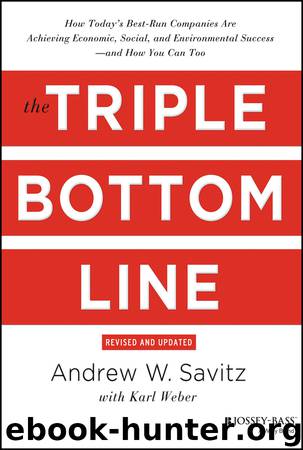The Triple Bottom Line by Andrew W. Savitz

Author:Andrew W. Savitz
Language: eng
Format: epub
Publisher: Wiley
Published: 2013-09-25T16:00:00+00:00
Chapter 9
Shaping Your Sustainability Strategy
You may not be interested in strategy, but strategy is interested in you.
—Leon Trotsky, Russian Marxist revolutionary and theorist
Finding the Sweet Spot: Putting Sustainability at the Heart of Your Corporate Strategy
As we've already stressed, your sustainability approach and your overall business plan must ultimately be one and the same, not two separate programs working in parallel (or, far worse, at cross-purposes). If you take a close look at the specific strategic directions your department, business unit, or company has chosen to pursue—the business models, product and service categories, and markets that your company has identified as being ripe for growth—you will probably find that there is a recognizable sustainability component to each: an intersection between your business strategy and the interests of the wider world. This is the area we've defined as the Sustainability Sweet Spot.
The key to incorporating sustainability into strategic planning, then, is simple: always be on the lookout for the overlap between profit and the public good. That's where opportunities lie.
Consider the global strategy being pursued by Unilever, the $68 billion (2012) consumer products corporation known for its food, home care, and personal care products, marketed around the world under such familiar brand names as Dove, Hellman's, Lux, Ben & Jerry's, Lipton, Knorr, Sunsilk, and many others.
As defined by the company's executive leaders, Unilever's current corporate strategy focuses on five key priorities that combine to make up what they call “the Compass.”1 These five priorities are a better future for children, a healthier future, a more confident future, a better future for the planet, and a better future for farming and farmers. Each is explained and described in terms of specific Unilever products, strategies, and practices that embody it.
For example, “a better future for children” is exemplified by oral care products that encourage kids to brush their teeth, as well as Unilever's support for the FDI World Dental Federation, which works to bring access to advanced dental care to people around the world. Similarly, “a more confident future” is embodied in Dove's advertising campaigns, which use “real women” rather than ultrathin models to exemplify beauty, along with the work of the Dove Self-Esteem Fund, which supports mentoring and education programs for young women. “A better future for farming and farmers” is illustrated by Unilever's use of ethically and sustainably sourced ingredients in products like Lipton tea and Ben & Jerry's ice cream.
Thus each of these five priorities focuses on a specific sweet spot that promises both revenue and profit opportunities for Unilever and social or environmental benefits for people around the world.
At the same time, Unilever has also emphasized the importance of customers in the developing world for its future growth. In 2011, these customers already represented fully 56 percent of Unilever's revenue base, and the company estimates that this share will increase to 70 percent by 2020.2 Here again, identifying the sweet spot isn't difficult. Selling more products in the developing world represents a clear business victory for Unilever. Those sales will
Download
This site does not store any files on its server. We only index and link to content provided by other sites. Please contact the content providers to delete copyright contents if any and email us, we'll remove relevant links or contents immediately.
Hit Refresh by Satya Nadella(8854)
The Compound Effect by Darren Hardy(8508)
Change Your Questions, Change Your Life by Marilee Adams(7372)
Nudge - Improving Decisions about Health, Wealth, and Happiness by Thaler Sunstein(7242)
The Black Swan by Nassim Nicholas Taleb(6763)
Deep Work by Cal Newport(6563)
Daring Greatly by Brene Brown(6222)
Rich Dad Poor Dad by Robert T. Kiyosaki(6174)
Principles: Life and Work by Ray Dalio(5961)
Man-made Catastrophes and Risk Information Concealment by Dmitry Chernov & Didier Sornette(5646)
Playing to Win_ How Strategy Really Works by A.G. Lafley & Roger L. Martin(5497)
Digital Minimalism by Cal Newport;(5389)
Big Magic: Creative Living Beyond Fear by Elizabeth Gilbert(5351)
The Myth of the Strong Leader by Archie Brown(5237)
The Slight Edge by Jeff Olson(5200)
Discipline Equals Freedom by Jocko Willink(5156)
The Motivation Myth by Jeff Haden(5003)
Stone's Rules by Roger Stone(4857)
The Laws of Human Nature by Robert Greene(4772)
